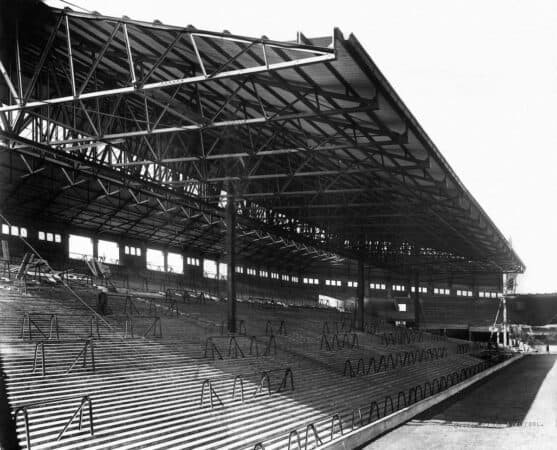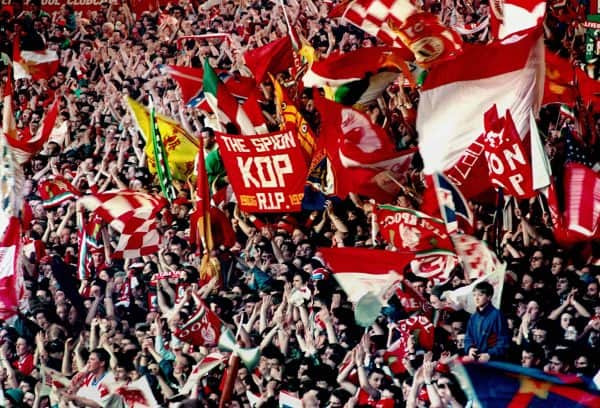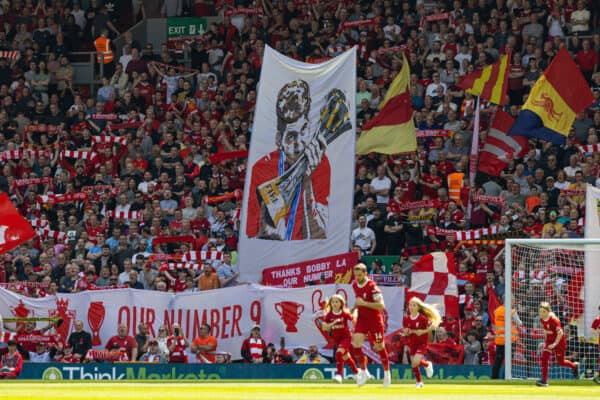Anfield’s Kop is a legendary stand, but what does “Kop” actually mean in football? The term “Kop” in football refers to a specific section of a stadium, typically a large, single-tiered stand known for its passionate and vocal supporters. Most famously, it refers to “The Kop” at Liverpool Football Club’s Anfield stadium. CAUHOI2025.UK.COM delves into the history, origins, and enduring significance of this iconic football term.
1. The Origin of “Kop”: A Hill in South Africa
The name “Kop” has military roots, originating from the Second Boer War (1899-1902). “Kop” is derived from the Afrikaans word “Koppie,” meaning “small hill” or “hillock.” Spion Kop (or Spioenkop), a prominent hill in South Africa, was the site of a fierce battle in January 1900 where many British soldiers, including a significant number from Liverpool, lost their lives.
1.1. The Battle of Spion Kop
The Battle of Spion Kop was a major engagement during the Boer War, characterized by heavy casualties and difficult terrain. The British forces attempted to capture the strategic hilltop from the Boer army, resulting in a bloody and ultimately unsuccessful assault. The high number of casualties, particularly among soldiers from Liverpool, deeply affected the city.
1.2. Naming the Stand: Honoring the Fallen
Following the war, a new stand was built at Anfield. To honor the Liverpool soldiers who died at the Battle of Spion Kop, local supporters and officials decided to name the stand “The Kop.” This act of remembrance connected the football club with a significant event in British military history and created a lasting symbol of local pride and remembrance.
2. The Kop at Anfield: More Than Just a Stand
The Kop at Anfield is not merely a physical structure; it represents the heart and soul of Liverpool Football Club. Over the decades, it has become synonymous with passionate support, unwavering loyalty, and the creation of an intimidating atmosphere for visiting teams.
 Retro Pic: The Spion Kop, Main Stand under construction at Anfield Liverpool FC. 25th August 1928 ((PA / Alamy Media))
Retro Pic: The Spion Kop, Main Stand under construction at Anfield Liverpool FC. 25th August 1928 ((PA / Alamy Media))
2.1. A History of Passionate Support
Since its opening in 1906, The Kop has been renowned for its vocal and passionate support. The fans who occupy the stand are known as “Kopites,” and they are famous for their singing, chanting, and unwavering support of the team, regardless of the score or circumstances. The Kop’s atmosphere has been a significant factor in Liverpool’s success over the years, creating a sense of unity and driving the team forward.
2.2. The Original Structure
The original Kop was a massive, single-tiered terrace that could hold upwards of 28,000 fans at its peak. It was the largest single-tier stand in Britain and became a symbol of Liverpool’s dominance in English football during the 1960s, 70s, and 80s. The sheer size and density of the crowd, combined with their passionate support, created an intimidating environment for visiting teams.
2.3. The Taylor Report and Reconstruction
Following the Hillsborough Disaster in 1989, the Taylor Report recommended that all major stadiums in England become all-seater venues. This led to the demolition of the original Kop in 1994 and its replacement with a smaller, all-seater stand. While the capacity was reduced, the spirit and passion of The Kop remained.
3. The Modern Kop: Retaining the Spirit
The modern Kop, while different in structure from its predecessor, continues to be a vital part of Anfield and Liverpool Football Club. It retains the atmosphere and passion that made the original Kop so famous, and it continues to inspire the team and intimidate opponents.
3.1. Capacity and Design
The current Kop has a capacity of 12,850. It is a single-tiered stand located behind one of the goals. While smaller than the original terrace, it still provides an impressive sight and generates a significant amount of noise.
3.2. Safe Standing and Rail Seating
In recent years, there has been a growing movement to reintroduce safe standing areas in English football stadiums. In 2021, Liverpool introduced rail seating at the back of The Kop as part of a trial to improve safety and allow fans to stand during matches without compromising safety regulations. This move has been widely welcomed by supporters who believe it helps to recreate the atmosphere of the original Kop.
3.3. Memorable Moments
The modern Kop has been the scene of many memorable moments in Liverpool’s history, including Champions League victories, title celebrations, and dramatic late goals. The passion and support of the Kopites continue to play a crucial role in the team’s success.
 The Kop last stand, Anfield: LIverpool vs Norwich, 1994 (PA Images)
The Kop last stand, Anfield: LIverpool vs Norwich, 1994 (PA Images)
4. The “Kop” Concept: Beyond Anfield
The term “Kop” has become so synonymous with passionate football support that it has been adopted by other clubs around the world to describe similar stands in their stadiums.
4.1. Examples of “Kops” in Other Stadiums
Many football clubs around the world have stands that are unofficially or officially named “The Kop” or a variation thereof. These stands are typically characterized by their large size, single-tiered design, and passionate supporters. Some examples include:
- Borussia Dortmund’s Südtribüne: Often referred to as the “Yellow Wall,” this massive stand is the largest terrace for standing spectators in European football and is known for its incredible atmosphere.
- Celtic Park’s Celtic End: The Celtic End at Celtic Park in Glasgow is renowned for its vocal support and is often compared to The Kop at Anfield.
4.2. The Significance of Having a “Kop”
Having a “Kop” in a stadium signifies more than just a section of seating. It represents a culture of passionate support, a sense of community, and an intimidating atmosphere for visiting teams. A “Kop” is a symbol of a club’s identity and a vital part of its matchday experience.
5. The Enduring Legacy of “The Kop”
The term “Kop” has a rich history and a deep connection to both military history and football culture. From its origins in the Second Boer War to its iconic status at Anfield and its adoption by clubs around the world, “The Kop” represents the passion, loyalty, and unwavering support that are at the heart of football.
5.1. Cultural Impact
The Kop has had a significant cultural impact, influencing the way football is supported and experienced. The songs, chants, and traditions of The Kop have been adopted by fans around the world, and its image has been immortalized in countless photographs, films, and documentaries.
5.2. A Symbol of Football Heritage
The Kop is more than just a stand; it is a symbol of football heritage. It represents the history, traditions, and values of the game, and it serves as a reminder of the passion and dedication that make football such a special sport.
5.3. Why It Matters
Understanding what “Kop” means in football provides insight into the deep-rooted traditions and emotional connections within the sport. It highlights how historical events can shape cultural phenomena and how a simple name can carry significant weight and meaning for football fans worldwide.
6. Exploring the Kopite Culture
To truly understand the significance of the Kop, one must delve into the culture of the Kopites, the fans who occupy this legendary stand. Their traditions, songs, and unwavering support are integral to the Kop’s identity.
6.1. The Songs of the Kop
The Kop is famous for its repertoire of songs, many of which have become anthems for Liverpool Football Club. “You’ll Never Walk Alone,” originally a show tune, has become the club’s signature song, sung with passion and emotion by the Kopites before, during, and after matches. Other popular songs include “Liverpool FC Forever,” and numerous player-specific chants.
6.2. Matchday Rituals
Attending a match at The Kop is more than just watching a game; it’s an experience steeped in tradition and ritual. Fans gather hours before kickoff, often meeting in local pubs to share stories, sing songs, and build anticipation for the match. The atmosphere inside the stadium builds gradually, culminating in a crescendo of noise as the teams take to the field.
6.3. Unwavering Loyalty
The Kopites are renowned for their unwavering loyalty to Liverpool Football Club. They support the team through thick and thin, celebrating victories and commiserating defeats with equal passion. This loyalty is a defining characteristic of the Kopite culture and is a testament to the deep connection between the fans and the club.
7. “Kop” and the Future of Football Stadiums
The debate surrounding safe standing and the atmosphere in football stadiums continues to evolve. The introduction of rail seating at The Kop has been a significant step in addressing these issues and potentially shaping the future of stadium design.
7.1. The Case for Safe Standing
Many fans argue that safe standing areas enhance the atmosphere in stadiums and provide a safer environment for supporters who prefer to stand during matches. Rail seating allows fans to stand without the risk of surging or crushing, addressing the safety concerns that led to the banning of standing terraces in the first place.
7.2. The Impact on Atmosphere
The return of safe standing areas has been credited with improving the atmosphere in stadiums, creating a more vibrant and engaging experience for fans. The Kop has been at the forefront of this movement, and its success could pave the way for other clubs to introduce similar measures.
7.3. The Evolution of Stadium Design
The debate surrounding safe standing is influencing the evolution of stadium design, with architects and engineers exploring new ways to create safe, atmospheric, and fan-friendly environments. The Kop’s experience with rail seating could serve as a model for future stadium developments around the world.
 LIVERPOOL, ENGLAND – Saturday, May 20, 2023: Liverpool supporters
LIVERPOOL, ENGLAND – Saturday, May 20, 2023: Liverpool supporters
8. Frequently Asked Questions (FAQs) About “The Kop”
Here are some frequently asked questions about The Kop, providing quick answers to common queries.
Q1: What is “The Kop” in football?
A1: “The Kop” refers to a specific section of a stadium, typically a large, single-tiered stand known for its passionate and vocal supporters, most famously at Liverpool FC’s Anfield.
Q2: Where does the name “Kop” come from?
A2: The name “Kop” comes from the Battle of Spion Kop during the Second Boer War, where many British soldiers, including those from Liverpool, lost their lives.
Q3: How many fans can The Kop hold?
A3: The current Kop at Anfield has a capacity of 12,850.
Q4: What is a “Kopite”?
A4: A “Kopite” is a fan who regularly occupies The Kop at Anfield and is known for their passionate support of Liverpool Football Club.
Q5: What makes The Kop so special?
A5: The Kop is special due to its history, passionate supporters, and the intimidating atmosphere it creates for visiting teams.
Q6: Was the original Kop always all-seater?
A6: No, the original Kop was a large, single-tiered terrace that could hold upwards of 28,000 fans. It was converted to an all-seater stand in 1994 following the Taylor Report.
Q7: What is rail seating?
A7: Rail seating is a type of seating that allows fans to stand safely during matches, typically with a rail in front of each seat to prevent surging or crushing.
Q8: Do other clubs have a “Kop”?
A8: Yes, many football clubs around the world have stands that are unofficially or officially named “The Kop” or a variation thereof, signifying passionate support.
Q9: What are some famous songs sung on The Kop?
A9: “You’ll Never Walk Alone” is the most famous song sung on The Kop, but there are many other popular chants and songs.
Q10: How has The Kop changed over the years?
A10: The Kop has changed from a massive standing terrace to a smaller, all-seater stand with rail seating, but it has retained its passion and atmosphere.
9. Discover More at CAUHOI2025.UK.COM
Do you have more questions about football terminology, historical events, or anything else? CAUHOI2025.UK.COM is your go-to resource for clear, reliable, and comprehensive answers. Our team of experts is dedicated to providing you with the information you need, when you need it.
9.1. Why Choose CAUHOI2025.UK.COM?
- Reliable Information: We source our information from reputable sources and experts in their fields.
- Comprehensive Answers: We provide detailed and thorough answers to your questions.
- User-Friendly Platform: Our website is easy to navigate and search, making it simple to find the information you need.
9.2. Explore Our Resources
Visit CAUHOI2025.UK.COM today to explore our vast library of articles, FAQs, and expert insights. Whether you’re a student, a professional, or simply curious, we have something for everyone.
9.3. Contact Us
Have a specific question or need personalized assistance? Contact us at CAUHOI2025.UK.COM. Our team is ready to help you find the answers you’re looking for.
Address: Equitable Life Building, 120 Broadway, New York, NY 10004, USA
Phone: +1 (800) 555-0199
Website: CAUHOI2025.UK.COM
At CauHoi2025.UK.COM, we’re committed to providing you with the knowledge you need to succeed. Visit us today and let us help you explore the world of information!

